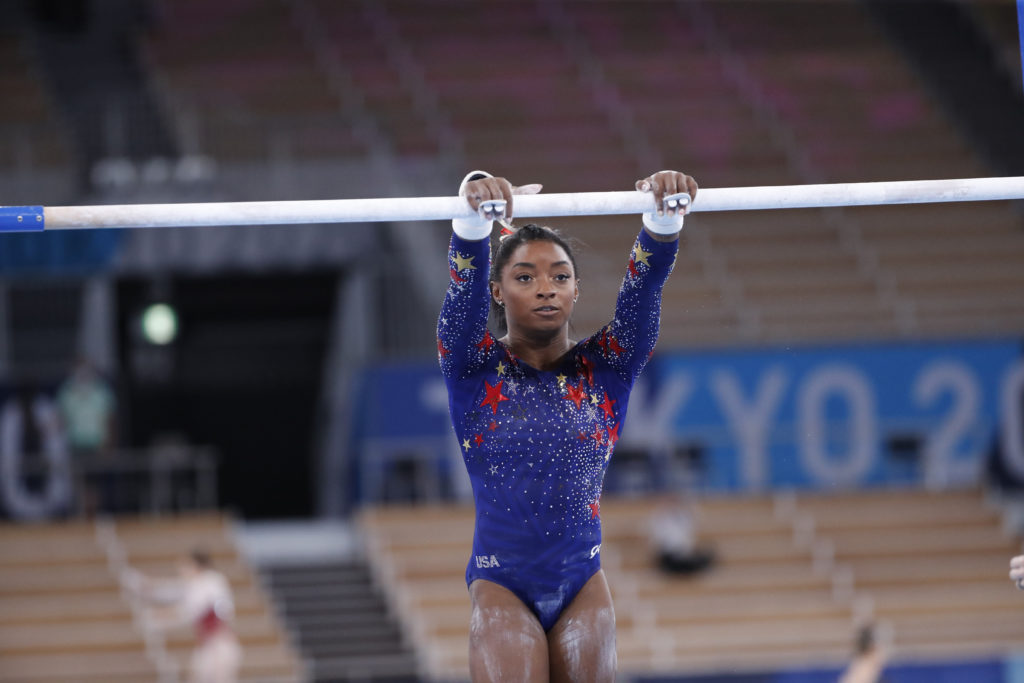
Did you watch the Tokyo Olympics during its two-week run?
Conventional wisdom is that the 2020 games – that got delayed a year due to COVID – were a dumpster fire, a train wreck, and a hot mess combined. The pandemic forced the IOC to reschedule the games, but that was just the start. Low vaccine rates in Japan, coupled with the rise of the Delta variant, impacted the health of many athletes. Scores of athletes tested positive, and weren’t allowed to participate in the games.
For health reasons, the decision was made to ban fans from events, so much of the competition took place in empty stadiums. Then there were the athletes that suffered from the stress of the competition and the bright lights, including Simone Biles who came down with a serious case of “the twisties,” forcing her to pull out of several events.
And then there were the weak ratings suffered by NBC-TV. Across the news media, late night TV, and morning radio, the conventional wisdom was that relatively few were watching the games on television.

But as Nieman Lab journalist Michael J. Socolow reported last week, broadcast ratings alone fail to provide a true look at the total audience watching and enjoying the Olympics on other devices and different platforms.
Here’s is his money quote that will make you stop and reconsider how broadcast media are evaluated in 2021:
“In evaluating the Tokyo Games by traditional TV measures, critics miss NBC’s insight about how media consumption is changing.”
The video content generated by the NBC team was consumed on mobile phones, laptops, tablets, as well as on partner Comcast and their cable assets. Oh yeah, and it was also broadcast on network television.
And let’s not forget Peacock, NBC’s premium video network available by subscription. Socolow tells us the actual numbers of paid subscribers generated by Peacock may not be known for some time, but it obviously factored into eyeballs – and revenue – as well. (And how many new Peacock subscribers will forget to cancel or find they enjoy its programming so they continue paying for it?)
generated by Peacock may not be known for some time, but it obviously factored into eyeballs – and revenue – as well. (And how many new Peacock subscribers will forget to cancel or find they enjoy its programming so they continue paying for it?)
Of course, social media is yet another powerful source of consumption – and sharing by excited fans with large networks of their own.
So while NBC-TV’s sales team may end up having to give out make-goods to compensate for soft network ratings, the reality is that the Tokyo Olympic Games were profitable for NBC. But the archaic ways in which audiences are counted and combined make it challenging to accurately come up with “a number.”
Socolow takes us back to Barcelona in 1992, and an “ahead-of-its-time” viewership package: The Triplecast. It offered three channels of non-stop Olympics coverage for $29.95 per day – or $125 for the entire two weeks of games. At the time, the Triplecast was thought to be a bust as most American viewers were accustomed to watching the games for free.
But nowadays, we’re living in the “subscription economy,” a perfect setting for Peacock. We are now so accustomed to paying for quality content, the thought of a few more bucks a month isn’t a barrier for most of us.
Techsurvey 2021 revealed that 85% of our core radio listeners subscribe to at least one video streaming service; 70% currently pay for two or more. That Triplecast might have sounded like a pretty crazy deal back in ’92, but not so much today.
![]() But it’s this idea that Olympics consumption is taking place on myriad platforms that’s the key. Fans of these games are gravitating to devices and access that fit their needs at any given moment.
But it’s this idea that Olympics consumption is taking place on myriad platforms that’s the key. Fans of these games are gravitating to devices and access that fit their needs at any given moment.
If they’re holding a smartphone, they can check out Olympic events. If they’re on a laptop or desktop at work, there are lots of possibilities. And of course, if they’ve got a TV handy, they can check out highlights and live coverage on several different platforms at their convenience.
Between its live coverage, time-shifting, and device accessibility, if the idea is to, in fact, “meet the audience where they are,” NBC hit goal. Sadly for them, they were not able to monetize this quadrennial spectacular as completely as they should have. And they suffered reputationally as media coverage almost universally reported their efforts as a disaster.
NBC’s supposed debacle in the Olympics is similar to the post-mortems other networks endure in the days after the Oscars, the Super Bowl, and other major events where consumers increasingly lean in on their preferred devices and at their convenience.
The ways in which consumers accessed content for the Tokyo games sound an awful lot like how they’re using broadcast radio these days.
We know consumption of AM and FM radio content had been gravitating to the web over the past decade or so: on apps, via computer streaming, on smart speakers, on-demand, and even on Sonos-type systems and connected televisions.
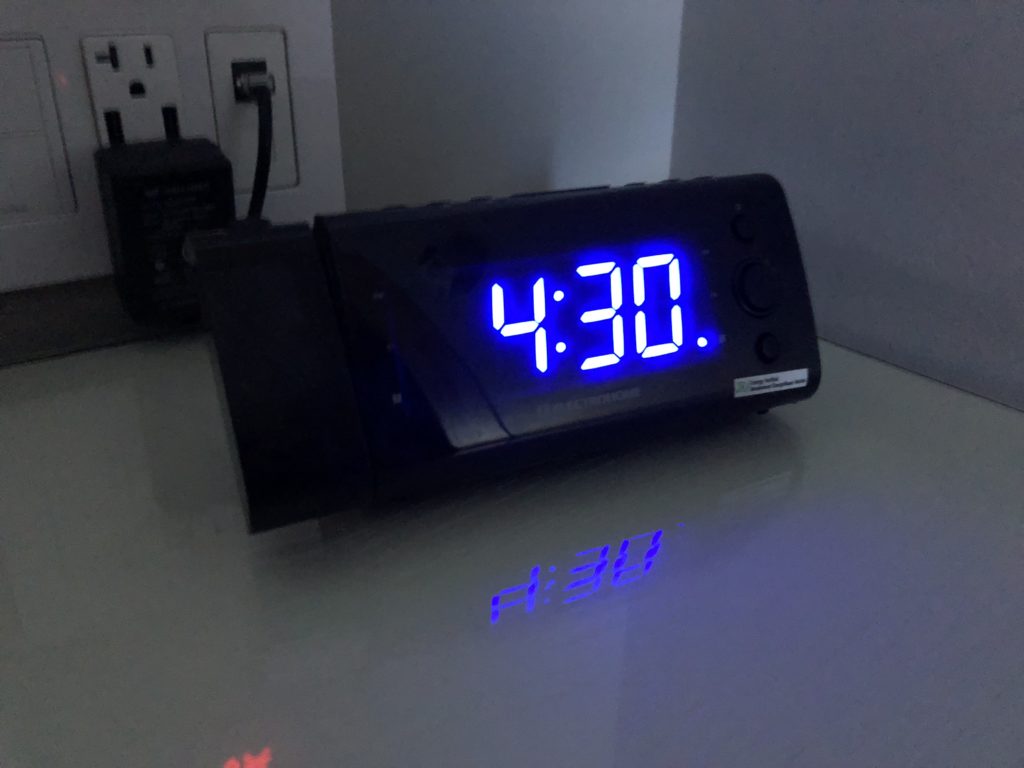 But the pandemic accelerated this trend. As many consumers found themselves working from home – and not in their cars or workplaces – their usage patterns changed. Many found themselves without a working radio at home and/or having it inconveniently located in a different part of the house, condo, or apartment.
But the pandemic accelerated this trend. As many consumers found themselves working from home – and not in their cars or workplaces – their usage patterns changed. Many found themselves without a working radio at home and/or having it inconveniently located in a different part of the house, condo, or apartment.
Streaming to the rescue. And many radio broadcasters will tell you that while their average ratings are indeed lower since COVID, their streaming numbers have gone straight up, increasing in some cases, by leaps and bounds.
We see evidence of this every year in our Techsurveys. The most recent, fielded in January/February of this year, was a perfect “screen cap” of pandemic consumption patterns.
Our Traditional/Digital question that asks radio fans to tell us how they consume their favorite stations has been showing this unmistakable trend in survey after survey. And it did not abate during COVID.
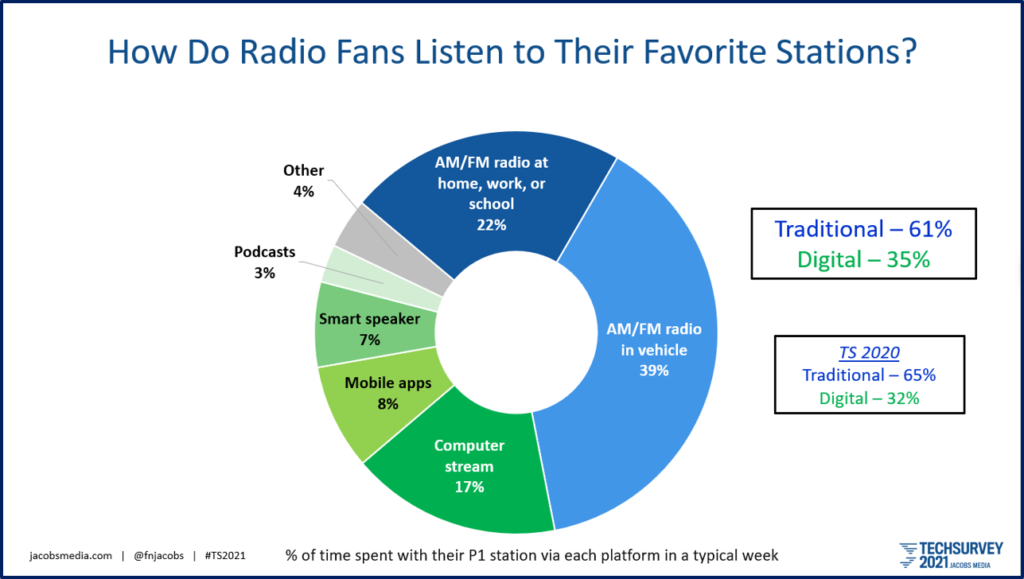
“Traditional” is consumption that takes place on actual radios – at home, at work, in school, and in the car. It now represents 61% of overall usage (down from 2020’s total of 65%).
Conversely, “digital” represents streaming on computers, mobile devices, smart speakers, and podcasts/on-demand – now a combined 35% of total consumption. And digital usage of a radio station’s assets took a jump from pre-pandemic 2020 when “digital” was at the 32% level.
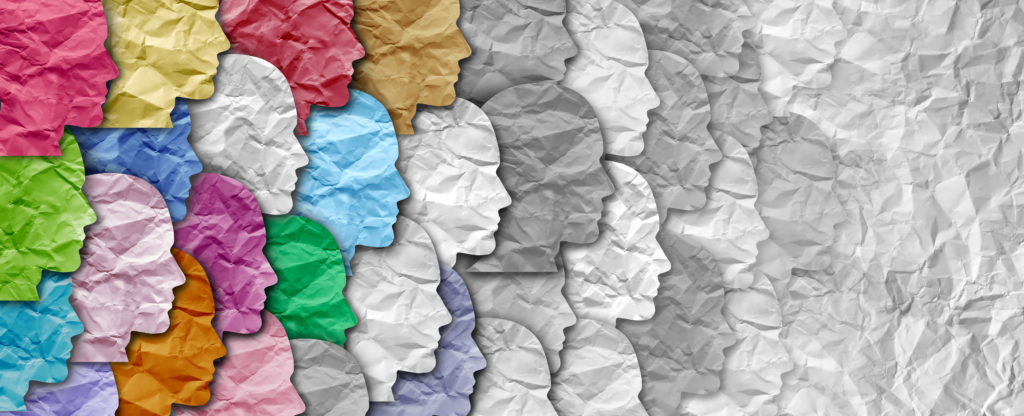 While Nielsen did a nice job of tracking how overall radio listening dipped in 2020 after the virus hit, radio broadcasters continue to get an unfair shake from their digital efforts.
While Nielsen did a nice job of tracking how overall radio listening dipped in 2020 after the virus hit, radio broadcasters continue to get an unfair shake from their digital efforts.
It is why more and more broadcasters have gone the “Total Line Reporting” route – adding their streaming and over the air numbers together, rather than attempting to sell both assets separately.
Nielsen’s headphone “tack-on,” implemented last fall, has helped but is just a band-aid. The lack of an aggregate, combined number that shows just how broad and expansive radio listening has become is costing the radio industry untold millions or even more in lost revenue.
It also disincentivizes broadcasters to invest in these digital assets. When their ROI is minimized by agencies or not even taken into account, why pour more dollars into ensuring the listening experience is competitive?
Why does radio only generate a relative pittance from the growing audience it attracts from its digital consumption? After all, ears are ears.
But the industry allows the advertising community to devalue the collective audience, depending on where and how they’re listening.
In past blog posts, we have talked about Nielsen ONE, a new service designed to address the cross-platform measurement process. What it covers,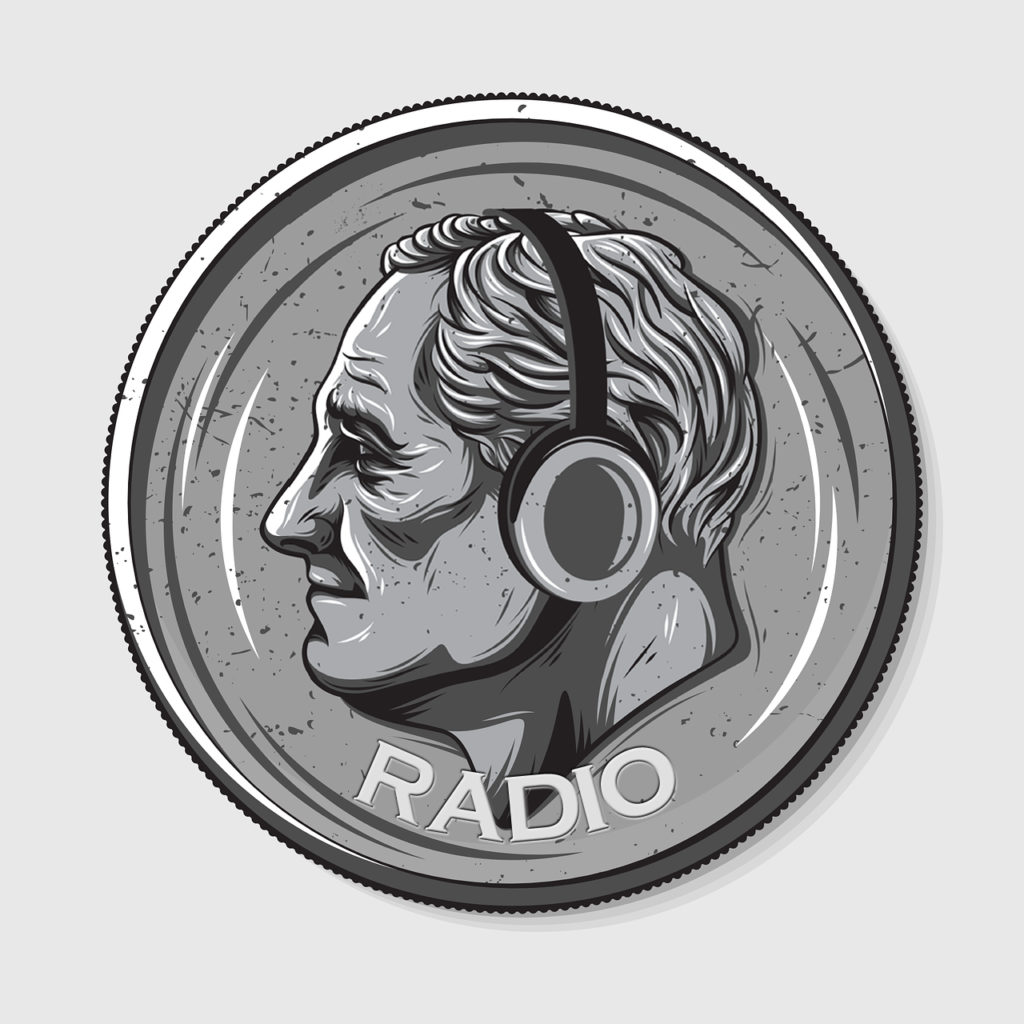 what it looks like, what it costs, and how it will be rolled out to advertisers are the devilish details.
what it looks like, what it costs, and how it will be rolled out to advertisers are the devilish details.
At the very least, radio broadcasters should be asking tough questions that address the future of its content, its platforms, and its revenue generation.
I can think of no better place to address these thorny issues than the upcoming NAB/RAB Show in October. Why not convene a panel that includes Nielsen, the MRC, the NAB, and RAB that addresses these issues head-on?
Let’s declare an end to this extended period of broadcast bucks vs. digital dimes.
- What Is It With Female Robot DJs? - April 30, 2025
- Why “Dance With Those Who Brung You” Should Be Radio’s Operating Philosophy In 2025 - April 29, 2025
- The Exponential Value of Nurturing Radio Superfans - April 28, 2025



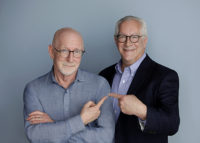
I am so glad someone wrote about this, I was just sharing these same sentiments with a colleague, this narrative of negativity (at least in my opinion good ratings would not have been reported half as heavily) & culture of not sharing what it true is a joke. Just asking the simple question of “are they factoring in social coverage (tik tok alone was blowing up daily with olympics stuff…millions of views), news outlet coverage, online platform coverage, etc. gets us closer to a real story, & if we are all about data, why settle for less, or let news outlets that benefit from low ratings of their competitors tell us how to think.
Great turn midway through & lesson for us in radio as well…love this piece.
James, thanks for this. As an industry, broadcasting is ahead of the games, but so behind in the ratings. And it’s hurtful, because all that multi-platform content creation, distribution, and marketing are pricey. Too often, TV and radio aren’t being compensated for what they’re bringing to the table.
Great article Fred.
I subscribed to the Olympic TikTok channel, and I also caught several highlights on Snapchat, Twitter, and Facebook. Plus on the tv service I subscribe to there was an Olympic Channel and an Olympic News Channel in addition to NBC, NBC Sports, and the USA Network airing coverage. The Kevin Hart and Snoop Dog highlights went viral, and for good reason, they were hilarious!
“the archaic ways in which audiences are counted and combined” is spot on, and it goes double for diary radio markets. A diary? Really? Is the mechanic listening in a shop really going to fill out a diary?
As if fighting to stay relevant wasn’t hard enough these days. Imagine being out on location and having a listener or client ask you about how ratings are compiled. Imagine explaining that a company sends out diaries and listeners are asked to take out their pens and pencils and write down what station they listened to and at what time. Pencil and paper diary in 2021. It lends to the perception we fight against all the time, that radio itself is archaic.
As always, thanks for the great articles!
Craig, your comment typifies the changing way consumers are enjoying the game. Technology is at the forefront. And yet, the diary ratings system doesn’t just seem archaic – it IS a prehistoric ratings methodology in a modern world. And it is special moments like the Olympics where this become abundantly clear. Thanks for the kind comments and for reading our blog.
NBC’s job – for its shareholders and advertisers was to deliver an audience at a price. That fact that there was a lot of sharing of media that someone else monetized hardly seems like a backhanded compliment – more like NBC bringing a knife to a gun fight. When you spend a lot of money on rights, its with the presumption that you can monetize them – I’m sure that the Chinese are very grateful to NBC for all of the TIkTok videos they enabled that the Chinese profited from at no cost.
Now radio. First, in the PPM markets, doesn’t Nielsen measure stream listening? And if they do, wouldn’t the results be device agnostic and register whether a laptop or smart speaker? If 17 % of radio listening is now online, a 5 share radio station should showing up in Nielsen with just under a 2 share for their stream and I don’t recall seeing anything close to that – ever. I acknowledge that I may be missing something here – please set me straight if I am. Further, are they still enforcing that AFTRA thing where they have to pay extra to run ads on streams, or can they just insert them? If not, then there’s that pesky monetization thing again.
As far as the Olympics, I never understood why they didn’t make them a vax only event – spectators, trainers, athletes, media. I think Pfizer/Moderna are charging around $25/shot. Somehow that seems workable. Yes, some would have had breakthrough infections and had to leave, but most could have performed, watched or played some sort of support role if they had their second shot two weeks before arriving in Tokyo.
The crowd has always been a big part of sports and I have to think that without one, this was less exciting for fans and harder for the athletes.
Bob, thanks for opining here. I hear what you’re saying about NBC, its promises to advertisers, and its commitments to expanding its media outlets. The story is a commentary about this awkward stage we’re going through in broadcasting. It may be a case where fans appreciated NBC’s efforts to expand its distribution outlets, while the rest of the media trashed them.
As for stream measurement, it is specious at best. Headphone listening is just a rough estimate, bearing little reflection what listeners are doing in the moment – especially during a major event like the Olympics. And broadcasters are seeing significant stream usage starting in early 2020 when the pandemic struck.
And I agree the event should have been “vax only” for everyone. But I feel that way about all sporting events, concerts, Broadway plays, and even restaurants. I think the timing was bad. If the Olympics were next week, it might have happened.
This article makes me wonder if Neilson needs to up it’s game… a lot. We don’t buy the ratings here, but I wonder if my company and other radio companies would buy it if they started to factor in things that AREN’T the “radio radio”. It’s hard as a PD to argue for ratings, when they refuse to show the whole picture.
As always, adapt or die.
We’re on the same page, Tammie. And if we’re going to get fired for “lousy ratings,” let’s be sure we count it all.